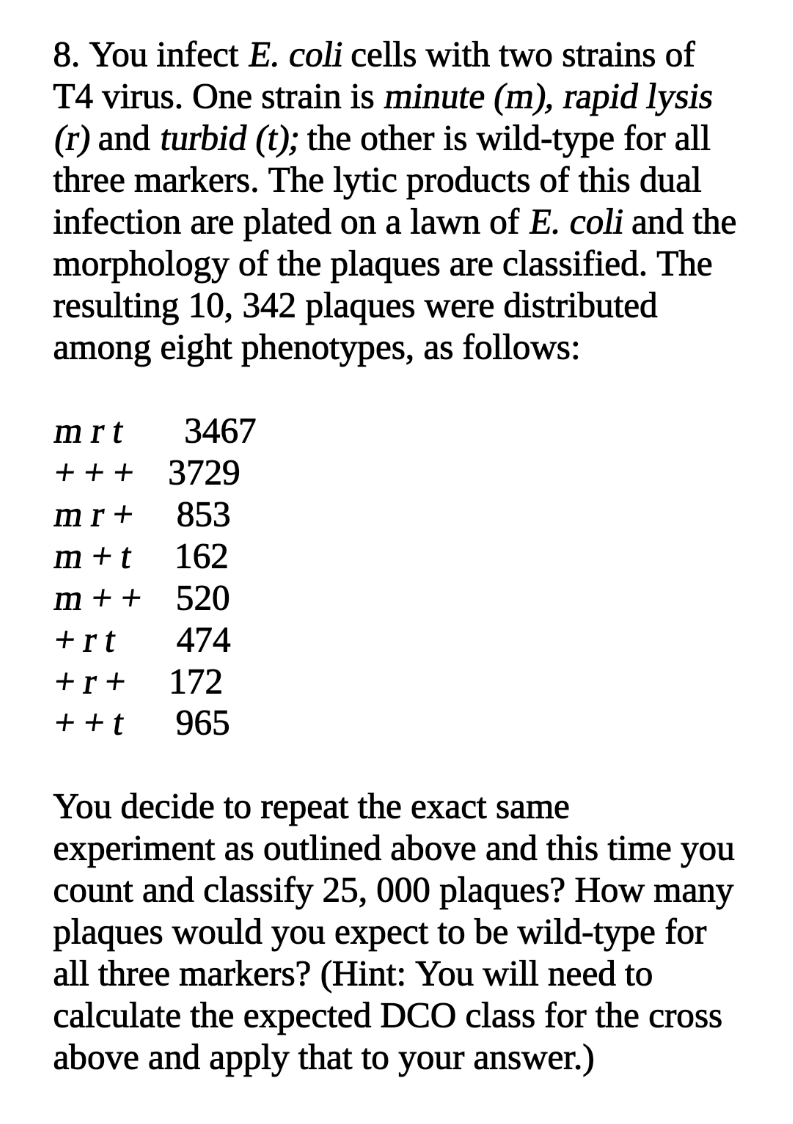8. You infect E. coli cells with two strains of T4 virus. One strain is minute (m), rapid lysis (r) and turbid (t); the other is wild-type for all three markers. The lytic products of this dual infection are plated on a lawn of E. coli and the morphology of the plaques are classified. The resulting 10, 342 plaques were distributed among eight phenotypes, as follows: mrt 3467 +++ 3729 mr+ 853 m+t 162 m++ 520 +rt 474 +r+ 172 ++t 965 You decide to repeat the exact same experiment as outlined above and this time you count and classify 25, 000 plaques? How many plaques would you expect to be wild-type for all three markers? (Hint: You will need to calculate the expected DCO class for the cross above and apply that to your answer.)
8. You infect E. coli cells with two strains of T4 virus. One strain is minute (m), rapid lysis (r) and turbid (t); the other is wild-type for all three markers. The lytic products of this dual infection are plated on a lawn of E. coli and the morphology of the plaques are classified. The resulting 10, 342 plaques were distributed among eight phenotypes, as follows: mrt 3467 +++ 3729 mr+ 853 m+t 162 m++ 520 +rt 474 +r+ 172 ++t 965 You decide to repeat the exact same experiment as outlined above and this time you count and classify 25, 000 plaques? How many plaques would you expect to be wild-type for all three markers? (Hint: You will need to calculate the expected DCO class for the cross above and apply that to your answer.)
Biology: The Unity and Diversity of Life (MindTap Course List)
14th Edition
ISBN:9781305073951
Author:Cecie Starr, Ralph Taggart, Christine Evers, Lisa Starr
Publisher:Cecie Starr, Ralph Taggart, Christine Evers, Lisa Starr
Chapter15: Studying And Manipulating Genomes
Section: Chapter Questions
Problem 12SQ: Which of the following can be used to carry foreign DNA into host cells? Choose all correct answers....
Related questions
Question

Transcribed Image Text:8. You infect E. coli cells with two strains of
T4 virus. One strain is minute (m), rapid lysis
(r) and turbid (t); the other is wild-type for all
three markers. The lytic products of this dual
infection are plated on a lawn of E. coli and the
morphology of the plaques are classified. The
resulting 10, 342 plaques were distributed
among eight phenotypes, as follows:
mrt
3467
+++ 3729
mr+ 853
m+t 162
m++
520
+rt 474
+r+ 172
++t 965
You decide to repeat the exact same
experiment as outlined above and this time you
count and classify 25, 000 plaques? How many
plaques would you expect to be wild-type for
all three markers? (Hint: You will need to
calculate the expected DCO class for the cross
above and apply that to your answer.)
Expert Solution
This question has been solved!
Explore an expertly crafted, step-by-step solution for a thorough understanding of key concepts.
This is a popular solution!
Trending now
This is a popular solution!
Step by step
Solved in 1 steps

Recommended textbooks for you

Biology: The Unity and Diversity of Life (MindTap…
Biology
ISBN:
9781305073951
Author:
Cecie Starr, Ralph Taggart, Christine Evers, Lisa Starr
Publisher:
Cengage Learning

Biology: The Dynamic Science (MindTap Course List)
Biology
ISBN:
9781305389892
Author:
Peter J. Russell, Paul E. Hertz, Beverly McMillan
Publisher:
Cengage Learning

Biology: The Unity and Diversity of Life (MindTap…
Biology
ISBN:
9781337408332
Author:
Cecie Starr, Ralph Taggart, Christine Evers, Lisa Starr
Publisher:
Cengage Learning

Biology: The Unity and Diversity of Life (MindTap…
Biology
ISBN:
9781305073951
Author:
Cecie Starr, Ralph Taggart, Christine Evers, Lisa Starr
Publisher:
Cengage Learning

Biology: The Dynamic Science (MindTap Course List)
Biology
ISBN:
9781305389892
Author:
Peter J. Russell, Paul E. Hertz, Beverly McMillan
Publisher:
Cengage Learning

Biology: The Unity and Diversity of Life (MindTap…
Biology
ISBN:
9781337408332
Author:
Cecie Starr, Ralph Taggart, Christine Evers, Lisa Starr
Publisher:
Cengage Learning